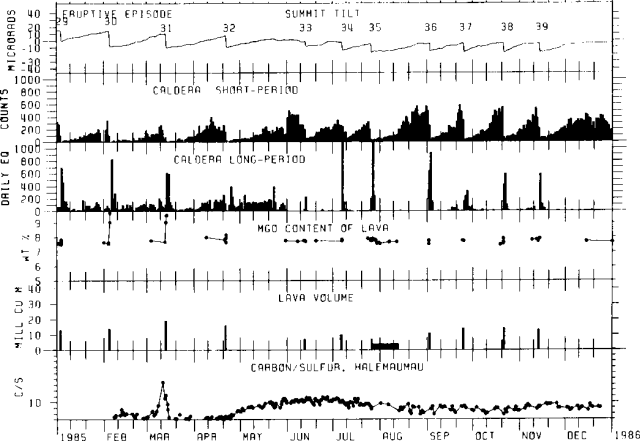Report on Kilauea (United States) — August 1985
Scientific Event Alert Network Bulletin, vol. 10, no. 8 (August 1985)
Managing Editor: Lindsay McClelland.
Kilauea (United States) Fissure activity ends; new episode three weeks later
Please cite this report as:
Global Volcanism Program, 1985. Report on Kilauea (United States) (McClelland, L., ed.). Scientific Event Alert Network Bulletin, 10:8. Smithsonian Institution. https://doi.org/10.5479/si.GVP.SEAN198508-332010
Kilauea
United States
19.421°N, 155.287°W; summit elev. 1222 m
All times are local (unless otherwise noted)
A decrease in harmonic tremor on 12 August at 0430 indicated the end of episode 35 lava production from fissures uprift of Pu`u `O`o vent. The fissure activity formed a small lava shield at the W base of Pu`u `O`o. The total volume of lava erupted during episode 35 was estimated to be 11.7 x 106 m3. Kīlauea's summit began to reinflate on 8 August, four days before the end of the fissure activity. By the onset of the next eruptive episode, on 2 September, the summit had recovered 12.9 µrad, compared with the 12.1 µrad of deflation that accompanied episode 35 (figure 36).
EPISODE 36
After only 21 days of repose, episode 36 began on 2 September at 1400. Fountaining at the Pu`u `O`o vent increased slowly during the first 3 hours from 100 m to over 300 m high. The fountains fed a broad aa flow that extended 2.5 km SE on top of previous flows, and a small 1.8-km flow to the NE. Harmonic tremor was first recorded about 1 hour prior to the start of the episode. The seismic station at nearby Pu'u Kamoamoa was moved uprift during episode 35, so the tremor signal from episode 36 was not as sensitive as in the past.
Summit deflation started on 2 September at 1300, one hour before fountaining began. Fountains stopped abruptly at 2335, after 9.5 hours of activity, but subsidence continued until 0300 on 3 September, totalling 11.7 µrad before inflation resumed (figure 37). The episode 35 fissure system remained inactive during episode 36. The September activity extended the duration of the ongoing eruption, beginning in January 1983, to 33 months.
Geological Summary. Kilauea overlaps the E flank of the massive Mauna Loa shield volcano in the island of Hawaii. Eruptions are prominent in Polynesian legends; written documentation since 1820 records frequent summit and flank lava flow eruptions interspersed with periods of long-term lava lake activity at Halemaumau crater in the summit caldera until 1924. The 3 x 5 km caldera was formed in several stages about 1,500 years ago and during the 18th century; eruptions have also originated from the lengthy East and Southwest rift zones, which extend to the ocean in both directions. About 90% of the surface of the basaltic shield volcano is formed of lava flows less than about 1,100 years old; 70% of the surface is younger than 600 years. The long-term eruption from the East rift zone between 1983 and 2018 produced lava flows covering more than 100 km2, destroyed hundreds of houses, and added new coastline.
Information Contacts: G. Ulrich, C. Heliker, R. Hanatani, and R. Koyanagi, HVO.


